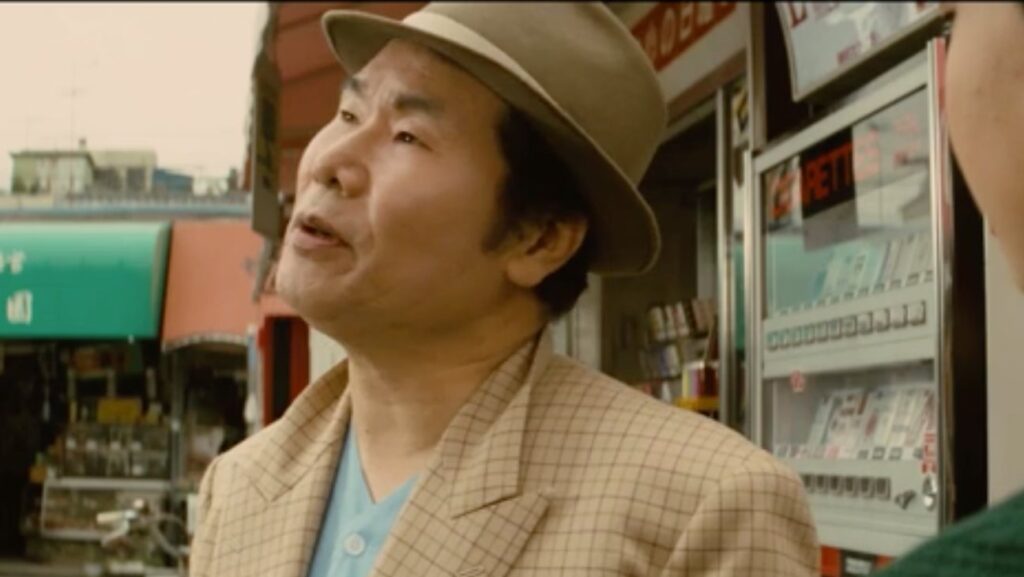Tora-san, Wish You Were Here, directed by Yoji Yamada, had its theatrical release in 2019. In fact, the 32nd Tokyo Int’l Film Festival in 2019 opened with the screening of this film. It is part of a popular series called Otoko wa tsurai yo (“It’s Tough Being a Man”). The film under review is the 50th in the series. It tells the story of the surviving members of Torajiro Kuruma’s family.
Tora-san, a bumbling Japanese travelling salesman, was portrayed by Kiyoshi Atsumi, an actor with brilliant comic timing. It is a story of how Tora-san’s family and friends remember Tora san many years after his death. It is a story of losses, fond remembrances and of cases of unrequited love. In this newest (and probably the final) instalment in the series, Tora san’s nephew Mitsuo had lost his wife six years ago. Mitsuo goes on a soul-searching journey to resolve old matters of the heart – regarding his childhood sweetheart, Izumi.
As in previous films in the series, a journey to another part of Japan is involved; also like in the previous films, this journey results in self-realisation. Only, this time it involves Mitsuo and his sweetheart instead of Tora-san. The audience gets to experience a sense of closure, as many unresolved questions regarding the romantic lives of both Tora-san and Mitsuo are dealt with in the film.
Yoji Yamada is perhaps best known for his film Twilight Samurai (2002), which was nominated for the Golden Berlin Bear in 2003 and the Academy Awards in 2004. But the Otoko wa tsurai yo series leaves behind a long legacy that spanned decades. It finds its place in the Guinness World Records as the longest running film series (49 films from the year 1969 to 1997) starring the same actor (also directed by the same director except in cases of two films in the series).
Related to Tora-San: 9 Must See Charlie Chaplin Movies And Where To Find Them
The films revolve around the character of Tora-san, a Chaplin-like vagabond with a pure soul, always looking out to mend broken hearts. He also was a ‘hopeless romantic’, but unable to marry and finally settle down. Till the very last film he remains a bachelor, a settled married life somehow eluding him repeatedly. A happy ending is not what his fate has in store for him. He has to return to his life of a drifter, away from his family. His dreams of romance and stability are fleeting, never really turning into reality.
This bittersweet quality of the films is known in Japanese as mono no aware (‘pathos of things’). The term mono no aware also captures this fleeting nature of happiness of the films. Each film introduces a new ‘Madonna’ or a romantic interest. The Tora-san films fall under the shoshimin eiga (more popularly known as shomin-geki/common- people’s drama among Western audiences and critics) genre which refers to ‘slice of life’ dramas portraying the lives of common people.
Most films would also start with Tora-san peddling his wares in different parts of a very scenic Japan. Although he is a romantic wanderer who appreciates the beauty of nature, Tora-san can never really sever his deep ties with his family. This longing always results in his return, at least once a year, to his roots – his hometown of Shibamata.
Historical Legacy
‘Tora san’ films had garnered quite a following among Asian audiences, but they are popular even now in European countries such as Austria. Although it is a long sequence of films, its popularity never really waned whilst its star was alive. Even after Atsumi’s sudden death from cancer, the director could never really think of replacing him with another actor. Kiyoshi Atsumi was indeed Tora san.
Yoji Yamada is now 88 years old. The world has gotten a lot smaller since he first started directing. It has also become more complicated, cruel and lonelier. He had decided recently to give a glimpse of the old Tora san to this new world. He commented in an interview, ‘In this age of uncertainty and unease, I sincerely hope that, like Tora-san’s line “There are times when I think it was good to be born,” this film’s [series] 50 years of production history will once again light a beacon of hope for audiences around the world.’ He brought the surviving cast back together, with the likes of Hidetaka Yoshioka (Mitsuo), Chieko Baisho (Tora san’s sister Sakura), Gin Maeda (Sakura’s husband) and the Ruriko Asaoka (Lily, Tora san’s most favoured ‘Madonna’).
Mitsuo is now a father himself, and a successful novelist. After the sixth death anniversary of his wife, his family members implore him to remarry. Even his daughter is not an exception. She thinks he is lonely and worries that she is the reason he is still single. The film uses flashbacks quite frequently. Often Mitsuo is deep in thought, wondering what his dear uncle Tora would say if he asked him for advice.
In some places the use of flashback feels a bit out of place. One can feel that it is being used to introduce, rather artificially, to the new generation the character that was Tora-san. However, it somehow does not ruin the overall mood of the film. It verges on the border of melodrama, but does not quite overdo it. It was one of Yamada’s chief virtues, it is refreshing to see it still is!
Every actor, specially the evergreen Chieko Baisho plays masterfully. She is as graceful and natural as ever. Gin Maeda too has not lost his gentle touch. After a chance encounter with his childhood flame Izumi, who now works for the United Nations High Commissioner for Refugees (UNHCR), Yamada deftly introduces in the story a major concern of the modern world — refugees of war, scattered in different parts of our planet, who are without home and without an identity.
The concept of home and family had been a highlight of this series. Yamada evidently still feels strongly about that theme. Yamada re-introduces to the audience the character of Lily, now older, wiser and a successful restaurateur. She was the one who almost managed to get Tora-san settled down; she was also one of the few Madonnas to reappear in several films throughout the series. This meeting of old friends will probably evoke a strong sense of nostalgia among old admirers of Tora-san films.
The scenes flow gently, talking about what could have been. Even answering the most sought-after question: why Tora-san did not marry Lily, or the other way round. A wholesome sense of family values permeates the whole film. It reminds the audience of a time when multi-generational families were frequently seen in Japan, perhaps even elsewhere in the world. The Suwa clan, or Tora-san’s family still have deep roots that tie everybody together. Scenes of three generations of the family sleeping together in futons on Tatami-matted floors nudge the viewers to think about that. Yamada seems to tell us that even if Japan is now an ultramodern society with a very low number of marriages and births, it does not have to lose its age-old tradition of family values.
Izumi and Mitsuo rediscover themselves, talking about unspoken feelings. Tora-san sometimes appears briefly and silently (restored footage inserted into the shot in post-production) in some scenes, watchfully keeping an eye on his favourite nephew. Rather than recasting another actor and using animated computer-generated imagery (CGI) to bring back Atsumi to life, Yamada pays a loving tribute to the character of Tora-san, using old film footage now digitally restored to 4k resolution.
This affection is evident in every part of the film, even though at times the editing and filmic approach seems a bit like that of a television series of yesteryears.
The new film will definitely rekindle the love of old admirers of the series; it may even encourage new and an ever-growing young, international audience interested in Asian films to watch the series for the first time.
Rating: 3.5/5
By Hiranmoy Lahiri
Recommended: Akira Kurosawa: 10 Greatest Films Of The Legend




